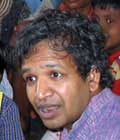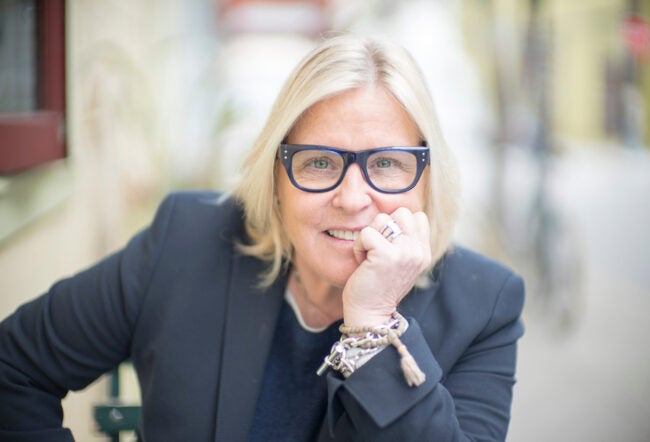In the 2004 film Swades (Homeland), the hero is an expat engineer who leaves a cushy job in the U.S. and moves to a village in India. Moved by the plight of the people, he organizes the residents and helps them hook a makeshift generator to a nearby waterfall, bringing electricity to the village for the first time. The movie was based loosely on the life and experience of Ravi Kuchimanchi, founder of the Association for India’s Development (AID), who worked with grass roots organizations to electrify 12 hamlets in Bilgaon, a tribal village. AID has evolved since its 1991 launch into a non-profit organization with more than 50 chapters that work on issues such as renewable energy and other forms of grassroots development. Kuchimanchi spoke with India Knowledge at Wharton during the recent Wharton India Economic Forum in Philadelphia.
An edited transcript of the conversation follows:
Knowledge at Wharton: We are speaking today with Ravi Kuchimanchi, who is the founder of the Association for India’s Development, otherwise known as AID. Ravi, thanks very much for joining us.
Kuchimanchi: Thank you.
Knowledge at Wharton: Can you tell us about the genesis of AID, and how it has grown over the years since you founded it in 1991?
Kuchimanchi: I was a graduate student at the University of Maryland in 1991. I basically thought that it would be good to have some channels where the Indian community in the U.S. could relate to the “real” India rather than only relating to the “Bollywood India” or to the markets in India; but also to rural India where 60% to 70% of India lives. That was the idea I had in mind when I sent out an email that led to the starting of this group — Association for India’s Development. Essentially, it channelizes the energy and interests of the non-resident Indian (NRI) community, both students and professionals. It seeks for them to learn about as well as participate in issues that are connected with rural India. They help out by raising funds as well as by giving knowledge inputs and by volunteering their time in both the U.S. and in India.
Knowledge at Wharton: You started out as one organization and you now have 50 chapters around the world.
Kuchimanchi: Yes that’s right. The organization started in College Park and after three years at the University of Maryland, it started spreading to other university campuses, like Pittsburgh, Princeton and so on. Over time, we had about 40 chapters in the U.S., and also small chapters sprouted in Australia and the UK — and that is how we grew. The other thing was that it moved from a student organization to also include professionals and the general NRI community. Right now, our mix is about 40% students in our chapters and about 60% are working people.
Knowledge at Wharton: Ironically, it was a Bollywood film called Swades that told your story. In fact, it was based on a project in which you provided electricity to the tribal village of Bilgaon. To what do you attribute the success of the project that the film was based on?
Kuchimanchi: The context of that project is that it is situated in the Narmada Valley. The Narmada Valley is very famous for the struggle against a large dam, the Sardar Sarovar Dam, which is displacing about two lakh [200,000] people just by its reservoir alone. The World Bank had in the beginning funded the project, but they now have recognized the problems with it and they have agreed that the project is faulty and they have withdrawn. But the project is continuing with the efforts of the Indian government.
It is within that context that we thought it was a very good idea to set up an example of an alternate energy — where electricity is generated based on village resources and can light up the village. In the case of these large dams, what happens is that the energy of the water is tapped and then it is fed to larger cities in India. And the villages that are being displaced themselves do not get any electricity from that project, so they do not develop locally. That is one contrast that we also wanted to show.
We collaborated with a group called the People’s School of Energy [PSE] which kind of provided the technical help to the project and the Narmada Bachao Andolan, which is the people’s movement which was raising the struggle in our group. The achievement of the project was that it was done entirely by shram daan [donated labor], which was essentially the volunteer labor from the people. It tapped the energy from a waterfall. There’s about a 9 to 10 meter waterfall in that village; it’s a beautiful waterfall. We diverted part of that water and dropped it 10 meters to turn a turbine, which produced electricity.
Knowledge at Wharton: Do you find that these projects each require a unique and innovative solution? Certainly lots of villages aren’t next to waterfalls, so you’ve probably had to find other methods for generating energy.
Kuchimanchi: That’s true. This is very applicable in tribal areas or in hilly areas actually. It doesn’t have to be a waterfall, but if there is a source of water, the hill naturally provides a conduit for the water to drop. And so, you can make a drop in a pipe by taking it some distance and then making it drop where the hill is steeper. You don’t really need a waterfall, but you need a source of water, and you need ups and downs, so that the water can be made to fall. That is there in many hills. Micro hydro projects of this kind have wide-ranging applicability. The Indian government is investing money through its Renewable Energy ministry to look at some of these ideas.
The other kinds of things that we are doing in this sector right now are this hay box that I wanted to show you. [Displays box] This is a bamboo box, and it’s made entirely in the village by a local artisan who gets paid about a $1 for making this whole thing. And then it is stuffed with straw. Now, straw or hay is a good insulator of heat and it is entirely lined — the cap and inside. If you put anything hot inside this box, it will remain hot for eight hours. It’s like a hot box for rural villages in India.
The other thing that it does is that it helps with cooking things like rice, potatoes and pulses [lentils] and so on. You boil something and then instead of continuing to cook with the fire, you put the boiling rice inside this and close it. The hay retains the heat, and in that heat the rice continues to cook and it will finish cooking there. You will save about 60% of the fuel by using this, and it also saves on greenhouse gases. For a village person, this saves on the cost of fuel, or for the time/cost it takes for a village woman to collect firewood. A typical village woman in India spends about two hours every day or every two days collecting the firewood for her family to burn. This saves time on that and it saves on cooking time as well. So, this is one thing that we are promoting.
Knowledge at Wharton: It makes perfect sense that it would work, and it seems so simple. Tell us a little bit about how you came up with this — thought that this would work.
Kuchimanchi: One of the things that I’m excited about is that this is made in a village and sold in a village. We sell it for 70 rupees [$1.75], which every village person can afford. There are very few technologies now [where that is possible]. A village can make things for the global market; that’s one of the current things. Countries like China, for example, are very good at doing that. But this is made and sold in villages in India, and I like that.
I came across this idea while I was on the Internet. Basically, I was looking for an efficient device to retain heat. I knew that hay was a good insulator. I was looking for solar heating systems. Through reflectors you can heat water up, but then, to keep the water hot, you have to put it into some insulating vessel which can be lined with hay, and it is a very low-cost insulator. And so, I was doing a search on the internet and I came across this idea of the hay box.
I read that the United Kingdom used hay boxes during the World War as a way to reduce fuel consumption in their country. And so, this is a known technology and what I realized was that this has a very good application for Indian villages in rural areas. And, immediately we tried to make it locally and then we were actually selling it to village people.
One of the fascinating things that this does for them is it also keeps food hot for eight hours. It not only helps with the cooking, but it will keep something hot — the rice stays hot for eight hours. They don’t have microwave ovens to heat up things and this is something that they are very excited about because they can get hot food any time of the day.
Knowledge at Wharton: It’s very simple but effective and fascinating. Obviously, your organization has grown over time through the participation of non-resident Indians. Do you see that trend continuing, and what do you think is driving it?
Kuchimanchi: I think that it’s a passion. You know people are both actually interested in it, both Indians and Americans. For example, we have potentially a Fulbright Scholar, who is from the U.S., who is probably going to be visiting and staying with us in India for about eight months. So, what drives these people, whether they are American or Indian is kind of a passion to change and to make the world a better place for everybody.
Somehow, there seems to be so much inequity in the world today. There’s a large fraction of the world that basically the resources are not reaching. And there is a lot of exploitation in the world. You know a lot of these people have remained poor because their rights have been trampled historically as well as continuing to be even today. Somehow, the youth of today wants to play a role in changing that.
Knowledge at Wharton: So you see it as a generational thing, specifically.
Kuchimanchi: Both a generational thing and maybe also because of the internet — that has really helped AID. It has given us an easier way to communicate and reach out to each other. And, it’s a cost effective way. Today, leadership can come from anywhere; but in a decentralized manner [through the internet] you can make your thoughts heard. And so, I think that this is also a part of it.
Knowledge at Wharton: Let’s talk a little bit about some of the new initiatives that you are focusing on as well. You are keeping an eye on the Right to Information Act and the National Rural Employment Guarantee Act that were passed in the country. Why are you stepping up your interests in those areas?
Kuchimanchi: Because they fundamentally have to do with democracy, like the Freedom of Information Act in the U.S. There is a lot of corruption in India and the government’s accountability to the people is something that we need to work on. As I was speaking today at the conference, the feedback from the people to the government, or to industry, even from the poor people, is something which is neglected. Without feedback, this is very difficult. For example, [it is like] the difference between compound and simple interest. In compound interest, the interest is fed back into the capital and generates more capital. If funds are invested in an account with simple interest, it has linear growth, it grows very slowly. But if they are invested in an account that offers compound interest, it grows exponentially, it grows very fast.
In the same way, it is very important for the voices of the people to be heard by the government. But people cannot lend their voices if they do not know what the government is doing. The Right to Information (RTI) Act essentially allows people to ask the government questions which they have to answer in a timely manner. And this [feedback] also helps fight corruption.
There are examples where if people have not gotten passports or ration cards, today they file an RTI application and ask what is the status of their application, what is the status of other people who have applied in the same way, what is the name of the government officer who is supposed to clear that paperwork but hasn’t done this so far. When you start asking these questions, often times the real work will get done. The officials will say, “Here is your ration card,” or “here is your passport.”
Knowledge at Wharton: Do you see your organization moving more in the direction of influencing policy in the future?
Kuchimanchi: Definitely, andI think that it has moved both in the past and it’s also continuing to move in the trajectory in influencing policy as well as the implementation of good laws, like the National Rural Employment Guarantee (NREG) Act. This is because our government is spending about $5 billion every year of taxpayer money in providing and guaranteeing 100 days of employment to every rural family in India. Of course, it’s not that way at all; the family actually works and is paid a minimum wage. But, they find the work and they have to give the work to these people. What we have found is that there are some areas in India, some states and some districts, where 70% of this money is not reaching the intended person but is being siphoned off. There are some states and some regions where this is actually working very well. This is something that happened in 2005 and it’s only been three years since it’s been implemented.
What our organization is keenly interested in doing is if there is new legislation that comes into India, we need to ensure its effective implementation; to give feedback to the government, to take it to the officials or administrators locally, as well as to the state representatives. And in cases where we find corruption or other faults in the implementation of the NREG Act or the RTI Act we can go to the courts, if necessary. We need to ensure that an accountable person is there implementing this progressive legislation — so that it happens. This is so we end up with not just good laws, but also good implementation of those laws. This is where India lags behind the U.S. quite a bit, I feel. In the U.S., I think they do a much better job of implementing its laws. In India while the laws are very progressive, but I feel that the implementation is lacking.
Knowledge at Wharton: What do you see as the largest hurdles on the horizon for organizations like yours? What are some of the biggest challenges?
Kuchimanchi: I think one of the biggest challenges is that a lot of solutions seem to be custom-made. There is no one effective solution that addresses a diverse country like India. There is no magic wand that you can wave to solve all of these things. And so, it requires people who are committed and [are willing to] spend more time. There is a learning curve for new people who get involved in this kind of thing as their chosen field of pursuit or as volunteers. There is a learning curve that they have to go through to be effective, and it requires staying power. Tapping human potential, making it stick — you know to handle all of these problems — and making them understand the complexities. And then, people will find what they can do.
Knowledge at Wharton: Ravi, thanks very much for speaking with us today.
Kuchimanchi: Thank you.



